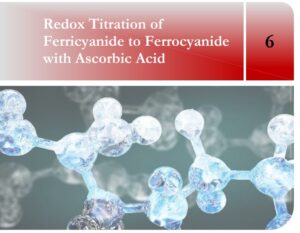 While spectroscopy is often used to directly quantify compounds in solution it can also help you measure and calculate other chemical properties. In this experiment, you will use visible spectroscopy to help measure the standard reduction potential for ferricyanide/ferrocyanide. You will gain experience with oxidation and reduction (redox) reactions and use both the Nernst equation and Beer’s law to calculate the standard reduction potential.
While spectroscopy is often used to directly quantify compounds in solution it can also help you measure and calculate other chemical properties. In this experiment, you will use visible spectroscopy to help measure the standard reduction potential for ferricyanide/ferrocyanide. You will gain experience with oxidation and reduction (redox) reactions and use both the Nernst equation and Beer’s law to calculate the standard reduction potential.
Redox Reactions
Ferricyanide, Fe(CN)63-, is an iron containing complex that can easily undergo redox reactions. Ferricyanide, a yellow Fe3+ complex, can be reduced (gain an electron) to ferrocyanide, a colorless Fe2+ complex: Fe(CN)6 3- (yellow) + e- → Fe(CN)64- (colorless) Since this redox reaction involves a color change (from yellow to colorless) it can easily be monitored using visible spectroscopy. You will use a spectrometer to measure the amount of light absorbed by the ferricyanide/ferrocyanide solution. Changes in absorbance will let you determine the progress of the redox reaction. Redox reactions involve both oxidation and reduction. An electron is needed to reduce ferricyanide to ferrocyanide. This electron is provided by oxidizing ascorbic acid (vitamin C) to dehydroascorbic acid:
ascorbic acid (C6H7O6) (colorless) → dehydroascorbic acid (C6H5O6) (colorless) + 2 H+ + 2e–
Both the ascorbic acid and the dehydroascorbic acid are colorless. That means that ferricyanide is the only colored ion in solution making it easy to spectroscopically measure the amount of ferricyanide in the solution.





